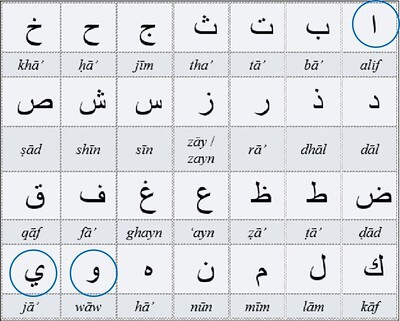Voynich Reconsidered: abjad languages
The Voynich manuscript contains, by my count, 158,943 glyphs. They are arranged in 40,699 strings which have the appearance of words. Thus the average length of a Voynich "word" is 3.91 glyphs. This is relatively short by comparison with the average length of words in most European languages.
The issue therefore arises as to whether the text of the Voynich manuscript is derived from an abjad language, in which the long vowels are written but the short vowels usually are not. The abjad languages typically have shorter words than fully phonetic languages (as are most European languages). Therefore, as a precursor of Voynich, any abjad language looks promising.
Examples of abjad languages include Arabic, Hebrew, Ottoman Turkish and Persian.
Recently I had the opportunity to correspond with Dr Jiří Milička of the Faculty of Comparative Linguistics at Charles University in Czechia. In my research on Arabic as a possible precursor language of the Voynich manuscript, I drew upon Dr Jiří Milička’s article “Average word length from the diachronic perspective: the case of Arabic”.
Our correspondence prompted me to set down some thoughts about abjad languages and Voynich.

The Arabic alphabet, with the three long vowels circled. Image credit: Mohamed Jaafari
If we could identify an abjad language which underlay the Voynich manuscript, we could probably narrow down the era in which it was written. As Dr Milička has demonstrated, Arabic words have gradually become longer over time, from the eighth century to the present day. The average length of an Arabic word in the fifteenth century was 4.12 letters; in the twentieth century, 4.30 letters.
I can think of two downsides of abjad languages, as I have written in my book Voynich Reconsidered (Schiffer Publishing, 2024).
One is that in modern times, the major abjad languages - at least Arabic, Hebrew and Persian - are written from right to left. To the best of my knowledge, that was so in medieval times. The text of the Voynich manuscript, when it occurs in horizontal lines, is left-justified, and gives the overwhelming impression of having been written from left to right. That does not exclude precursor documents written from right to left; but the transposition would have vastly increased the workload for the scribes, and therefore the cost to the producer.
The other danger with the hypothesis of an abjad language is that any short string of letters has a sporting chance of making a word. In 2016, Bradley Hauer and Grzegorz Kondrak proposed Hebrew as the precursor language, and suggested a Hebrew translation of the first line of page f1r. I tested their mapping against longer chunks of Voynich text, and it did not produce sensible narrative.
Having spent some years in Saudi Arabia and the United Arab Emirates, I am familiar with the Arabic alphabet. I have tested various correspondences between Voynich glyph frequencies and Arabic letter frequencies, and they yielded some short Arabic words, but they did not work for strings longer than three glyphs.
Likewise with Persian: the mappings produced some Persian words from strings up to three glyphs, but broke down at the four-glyph level.
In another post on this platform, I have proposed that in any proposed mapping from Voynich glyphs to a natural language, one needs to work with a sufficiently large chunk of Voynich text (at least a paragraph, or a page, or longer). In the case of abjad languages, I think it would be doubly important to work with reasonably long extracts from the Voynich text, in order to avoid producing apparently meaningful words by chance.
The issue therefore arises as to whether the text of the Voynich manuscript is derived from an abjad language, in which the long vowels are written but the short vowels usually are not. The abjad languages typically have shorter words than fully phonetic languages (as are most European languages). Therefore, as a precursor of Voynich, any abjad language looks promising.
Examples of abjad languages include Arabic, Hebrew, Ottoman Turkish and Persian.
Recently I had the opportunity to correspond with Dr Jiří Milička of the Faculty of Comparative Linguistics at Charles University in Czechia. In my research on Arabic as a possible precursor language of the Voynich manuscript, I drew upon Dr Jiří Milička’s article “Average word length from the diachronic perspective: the case of Arabic”.
Our correspondence prompted me to set down some thoughts about abjad languages and Voynich.

The Arabic alphabet, with the three long vowels circled. Image credit: Mohamed Jaafari
If we could identify an abjad language which underlay the Voynich manuscript, we could probably narrow down the era in which it was written. As Dr Milička has demonstrated, Arabic words have gradually become longer over time, from the eighth century to the present day. The average length of an Arabic word in the fifteenth century was 4.12 letters; in the twentieth century, 4.30 letters.
I can think of two downsides of abjad languages, as I have written in my book Voynich Reconsidered (Schiffer Publishing, 2024).
One is that in modern times, the major abjad languages - at least Arabic, Hebrew and Persian - are written from right to left. To the best of my knowledge, that was so in medieval times. The text of the Voynich manuscript, when it occurs in horizontal lines, is left-justified, and gives the overwhelming impression of having been written from left to right. That does not exclude precursor documents written from right to left; but the transposition would have vastly increased the workload for the scribes, and therefore the cost to the producer.
The other danger with the hypothesis of an abjad language is that any short string of letters has a sporting chance of making a word. In 2016, Bradley Hauer and Grzegorz Kondrak proposed Hebrew as the precursor language, and suggested a Hebrew translation of the first line of page f1r. I tested their mapping against longer chunks of Voynich text, and it did not produce sensible narrative.
Having spent some years in Saudi Arabia and the United Arab Emirates, I am familiar with the Arabic alphabet. I have tested various correspondences between Voynich glyph frequencies and Arabic letter frequencies, and they yielded some short Arabic words, but they did not work for strings longer than three glyphs.
Likewise with Persian: the mappings produced some Persian words from strings up to three glyphs, but broke down at the four-glyph level.
In another post on this platform, I have proposed that in any proposed mapping from Voynich glyphs to a natural language, one needs to work with a sufficiently large chunk of Voynich text (at least a paragraph, or a page, or longer). In the case of abjad languages, I think it would be doubly important to work with reasonably long extracts from the Voynich text, in order to avoid producing apparently meaningful words by chance.
No comments have been added yet.
Great 20th century mysteries
In this platform on GoodReads/Amazon, I am assembling some of the backstories to my research for D. B. Cooper and Flight 305 (Schiffer Books, 2021), Mallory, Irvine, Everest: The Last Step But One (Pe
In this platform on GoodReads/Amazon, I am assembling some of the backstories to my research for D. B. Cooper and Flight 305 (Schiffer Books, 2021), Mallory, Irvine, Everest: The Last Step But One (Pen And Sword Books, April 2024), Voynich Reconsidered (Schiffer Books, August 2024), and D. B. Cooper and Flight 305 Revisited (Schiffer Books, coming in 2026),
These articles are also an expression of my gratitude to Schiffer and to Pen And Sword, for their investment in the design and production of these books.
Every word on this blog is written by me. Nothing is generated by so-called "artificial intelligence": which is certainly artificial but is not intelligence. ...more
These articles are also an expression of my gratitude to Schiffer and to Pen And Sword, for their investment in the design and production of these books.
Every word on this blog is written by me. Nothing is generated by so-called "artificial intelligence": which is certainly artificial but is not intelligence. ...more
- Robert H. Edwards's profile
- 68 followers



